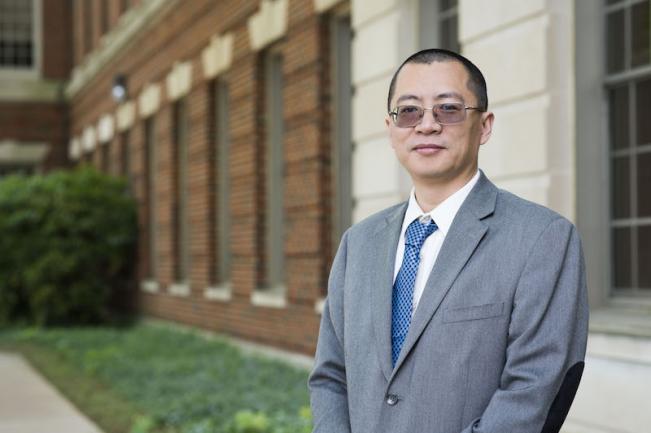GEORGETOWN ALZHEIMER’S RESEARCHER HAS “BRIGHTFOCUS”
June 16, 2016 – Xiong Jiang, PhD, believes there is a way to identify patients at an early enough stage in Alzheimer’s disease — well before clinical symptoms crop up — that they could be effectively treated with novel agents.
His ideas have earned him a 3-year $300,000 grant from the BrightFocus Foundation, and on June 9th he shared the details of the study he will undertake to test the method during a special reception: An Evening of BrightFocus.
The foundation reception at the new U.S. Institute of Peace in Washington featured philanthropists and nationally known scientists, including a Nobel laureate, among others. Jiang was among six foundation grant recipients selected to present his work.

DEVELOPING ALZHEIMER’S BIOMARKERS
Jiang, director of the Cognitive Neuroimaging Laboratory at Georgetown University Medical Center, will begin his study in July with the asstance of colleauges including R. Scott Turner, MD, PhD, director of Georgetown’s Memory Disorders Program.
Jiang plans to combine different MRI modalities to detect and quantify early pathological changes in the brain, including brain atrophy, decreased white matter integrity, and disrupted brain networks, along with other novel functional MRI techniques. Such an integrated approach is expected to be more sensitive and accurate in assessing Alzheimer’s disease related neuropathological changes, Jiang says. He will use this information to develop a “biomarker” — a signature of changes in the brain that has the potential to assess and predict development of Alzheimer’s.
“The hope is to identify changes in the critical period before symptoms can be detected in behavioral testing,” he says. “By the time you see symptoms there are already significant damages in the brain and it might be too late to initiate effective treatments.”
PILOT PROJECT
Jiang’s technique could also be used to track if novel agents effectively revert or stabilize the Alzheimer’s biomarker in patients.
The only way now to diagnose Alzheimer’s disease in an individual is through PET scanning to find amyloid, along with comprehensive neurological and neuropsychological assessments. “Both have limitations in drug development — behavioral testing is likely insensitive at an early stage of disease, and the radiation risk puts a limit on how often a patient can be scanned,” Jiang says. “By contrast, MRI is safe and can be repeated as many times as needed, which is very important during drug development.”
In his pilot MRI scanning project, Jiang plans to enroll 90 participants. They will be divided into three groups of 30 people: a control group, a risk group – cognitively normal individuals with a genetic risk and parents or siblings who have been diagnosed with Alzheimer’s, and 30 individuals diagnosed with mild cognitive impairment— early memory issues that raises the risk of developing Alzheimer’s by 10 times.
FUTURE TESTING
“Neuroimaging like MRI might become an alternative and/or an add on to behavioral assessment in clinical assessments and drug development,” Jiang says. “This could really make a difference in the future of Alzheimer’s disease diagnosis and treatment.”
The BrightFocus Foundation has awarded more than $163 million, supporting more than 1,3000 projects and an estimated 4,000 scientists, to develop new approaches to prevention, diagnosis, and treatment of Alzheimer’s disease, macular degeneration and glaucoma.
Media Contact Karen Teber
